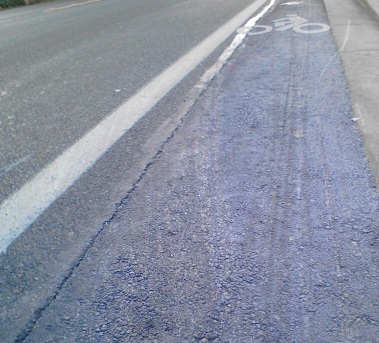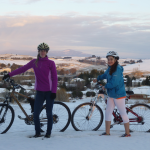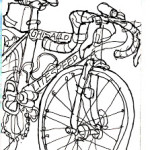We hear someone exclaim from time to time, “You don’t ride in this cold, do you?!” Some of these same people happily pack up their skis and head to the mountains to shiver on a lift, gear up for a hike in the woods, or get out the ice-fishing equipment and go chop holes in frozen water so they can sit for hours waiting for a bite. Somehow getting cold in the name of transportation is different from getting cold for recreation.
The beauty of bicycling is that it can be both practical transportation (bike lanes usually move freely while freeways and arterials jam with harried commuters, collisions, and slide-offs) and recreation of the “brisk and bracing” variety on a cold day. Staying warm enough to enjoy the ride is no more complicated than getting dressed to walk around your neighborhood and look at the holiday lights.
ABCs of Winter Bicycling
Appendages are all. That is to say, riding in the winter warms your core but those fingers, toes, ears, and other appendages will suffer most from cold temperatures and diminished circulation. Make sure they’re covered, preferably with some windproofing as well as insulation.
A few of the tips from our Twitter chat are summarized here. Add yours in the comments.
Feet
- Wool socks. Wool socks. Wool socks. Wear two layers on really cold days, as long as your shoes have enough room so the extra bulk doesn’t constrict circulation.
- You can ride in regular boots. Toe caps on the fronts of your shoes or full booties that zip on can provide additional protection against both wind and moisture; booties will help trap warmth.
Hands
- Lobster-claw gloves. You’ll be able to give the Vulcan greeting and fingers will be warmer because they’re together, while you still have enough dexterity to shift.
- “Pogies” — like big kitchen mitts that stay on your handlebars. Wear a pair of regular gloves below them.
Neck, Chin, Nose
- Neck gaiter. Keeps your neck warm and can be pulled up to cover the lower part of your face, then dropped as that gets too warm.
- Face mask. Borrow from the world of skiing; get one that covers your face from the nose down.
- Balaclava. Some find these uncomfortable under a helmet; the border can get squished into your forehead.
Ears and Head
- Helmet strap or ear covers. Knitters and crocheters can find patterns for helmet earwarmers on sites like Ravelry.
- Helmet cover. Worn on the outside of the helmet, this helps block wind and moisture.
- Hat. Wool is your friend here too. Get a thin one so it fits beneath the helmet and let your chin strap out a bit.
Base layers below. Wearing layers traps body heat and lets you adjust easily as you warm up from riding. Merino wool provides warmth even when damp, whereas cotton will stay wet and suck the heat out of you. No cotton.
Cycling chases the cold away. Dress so you feel a little too cool as you leave your home. You’ll warm up as you ride.
[Tweet “ABCs of #winterbiking: Appendages, Base layers, Cycling.”]
Twitter Tips for Winter Wheels
We asked on Twitter to find out what our followers consider to be essential gear.
Related Reading
- #WAbikes on Instagram: Baby, it’s damp and dark outside!
- Two Wheels After Turkey: Below Freezing Benefit Ride in Spokane (riders were definitely wearing their favorite cold-weather gear)
Your Turn
- What winter gear makes your riding more comfortable?





One Comment
Meteor double mittens from Outdoor Research are the best I’ve found for my easily frozen fingers. I can still shift and brake without problems, no gloves or lobster hands needed. Hiking boots when it gets below 25 degrees. Chemical handwarmers as a backup.